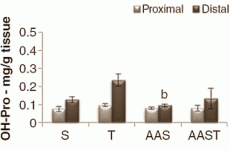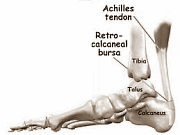Anabolic steroids prevent tendons from becoming stronger through training
Strength athletes who use anabolic steroids non-stop are almost bound to develop tendon problems, including the risk of tearing them. Brazilian physiologists came to this conclusion after doing experiments with rats. They believe that steroids, while boosting post-training muscle growth, also prevent muscle attachments from becoming stronger.
Strength athletes who use anabolic steroids non-stop are almost bound to develop tendon problems, including the risk of tearing them. Brazilian physiologists came to this conclusion after doing experiments with rats. They believe that steroids, while boosting post-training muscle growth, also prevent muscle attachments from becoming stronger.
The figure on the right above shows the strongest tendon in the human body: the Achilles tendon, or as it's called in anatomy textbooks, the calcaneal tendon. Researchers from the University of Brasilia will soon publish the results of their study on the effect of steroids on this tendon in the Scandinavian Journal of Medicine and Science in Sports.
They got half of their lab animals to do weight training five days a week. They put a kind of suit of armour on each animal which weighed about half of the animal's own weight. Then they got the animals to do four sets of 10 reps of jump squats. As the study progressed the researchers made the armour increasingly heavier.
The rest of the rats did no training.
Half of the rats that didn't train were not given steroids; the other half did get steroids [AAS]. Half of the rats that did train were not given steroids ; the other half did get steroids [AAS].
Strength athletes who use anabolic steroids non-stop are almost bound to develop tendon problems, including the risk of tearing them. Brazilian physiologists came to this conclusion after doing experiments with rats. They believe that steroids, while boosting post-training muscle growth, also prevent muscle attachments from becoming stronger.
The researchers used the anabolic steroid nandrolone decanoate. The Brazilians used Deca-Durabolin preparations produced by the Organon factory in Sao Paulo. The human equivalent of the dose they used was surprisingly low: 130-150 mg per week.
After seven weeks the lower part of the Achilles tendon – just above the heel – had become stronger in the rats that had done training. At least, the researchers found more hydroxyproline in that part of the tendon. But in the rats that had not only trained but had also been given nandrolone decanoate, the increase in the number of hydroxyproline units had not taken place. The tendon had not become stronger.
Strength athletes who use anabolic steroids non-stop are almost bound to develop tendon problems, including the risk of tearing them. Brazilian physiologists came to this conclusion after doing experiments with rats. They believe that steroids, while boosting post-training muscle growth, also prevent muscle attachments from becoming stronger.
Strength athletes who use anabolic steroids non-stop are almost bound to develop tendon problems, including the risk of tearing them. Brazilian physiologists came to this conclusion after doing experiments with rats. They believe that steroids, while boosting post-training muscle growth, also prevent muscle attachments from becoming stronger.
The figure above partially shows how steroids can stop tendons from growing. In the rats that had trained the circulation of blood in the Achilles tendon had increased, but that didn't happen if the rats had also been given nandrolone decanoate.
It's true that the negative effects of the steroid on the structure of the Achilles tendon were pretty small. But the researchers suspect that in the long term, as muscles continue to build strength and users can lift increasingly heavy weights, the consequences could be serious.

Strength athletes who use anabolic steroids non-stop are almost bound to develop tendon problems, including the risk of tearing them. Brazilian physiologists came to this conclusion after doing experiments with rats. They believe that steroids, while boosting post-training muscle growth, also prevent muscle attachments from becoming stronger.
Strength athletes who use anabolic steroids non-stop are almost bound to develop tendon problems, including the risk of tearing them. Brazilian physiologists came to this conclusion after doing experiments with rats. They believe that steroids, while boosting post-training muscle growth, also prevent muscle attachments from becoming stronger.
The figure on the right above shows the strongest tendon in the human body: the Achilles tendon, or as it's called in anatomy textbooks, the calcaneal tendon. Researchers from the University of Brasilia will soon publish the results of their study on the effect of steroids on this tendon in the Scandinavian Journal of Medicine and Science in Sports.
They got half of their lab animals to do weight training five days a week. They put a kind of suit of armour on each animal which weighed about half of the animal's own weight. Then they got the animals to do four sets of 10 reps of jump squats. As the study progressed the researchers made the armour increasingly heavier.
The rest of the rats did no training.
Half of the rats that didn't train were not given steroids
Strength athletes who use anabolic steroids non-stop are almost bound to develop tendon problems, including the risk of tearing them. Brazilian physiologists came to this conclusion after doing experiments with rats. They believe that steroids, while boosting post-training muscle growth, also prevent muscle attachments from becoming stronger.
The researchers used the anabolic steroid nandrolone decanoate. The Brazilians used Deca-Durabolin preparations produced by the Organon factory in Sao Paulo. The human equivalent of the dose they used was surprisingly low: 130-150 mg per week.
After seven weeks the lower part of the Achilles tendon – just above the heel – had become stronger in the rats that had done training. At least, the researchers found more hydroxyproline in that part of the tendon. But in the rats that had not only trained but had also been given nandrolone decanoate, the increase in the number of hydroxyproline units had not taken place. The tendon had not become stronger.
Strength athletes who use anabolic steroids non-stop are almost bound to develop tendon problems, including the risk of tearing them. Brazilian physiologists came to this conclusion after doing experiments with rats. They believe that steroids, while boosting post-training muscle growth, also prevent muscle attachments from becoming stronger.
Strength athletes who use anabolic steroids non-stop are almost bound to develop tendon problems, including the risk of tearing them. Brazilian physiologists came to this conclusion after doing experiments with rats. They believe that steroids, while boosting post-training muscle growth, also prevent muscle attachments from becoming stronger.
The figure above partially shows how steroids can stop tendons from growing. In the rats that had trained the circulation of blood in the Achilles tendon had increased, but that didn't happen if the rats had also been given nandrolone decanoate.
It's true that the negative effects of the steroid on the structure of the Achilles tendon were pretty small. But the researchers suspect that in the long term, as muscles continue to build strength and users can lift increasingly heavy weights, the consequences could be serious.






